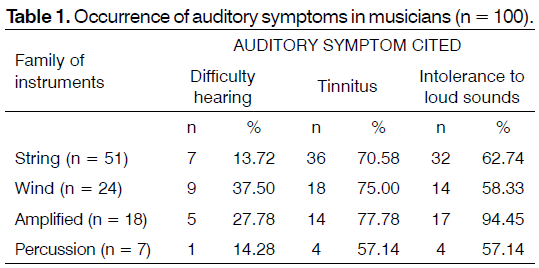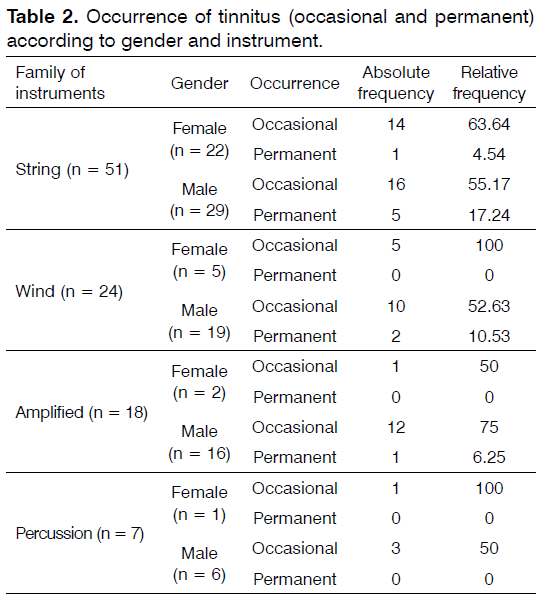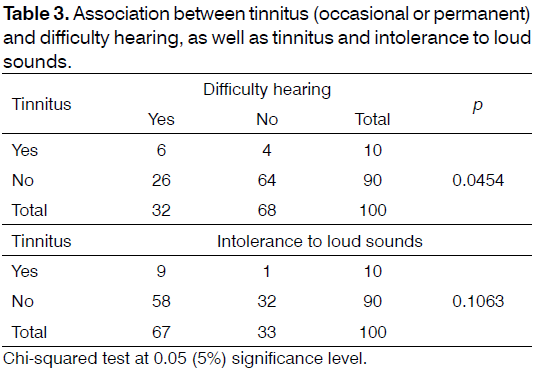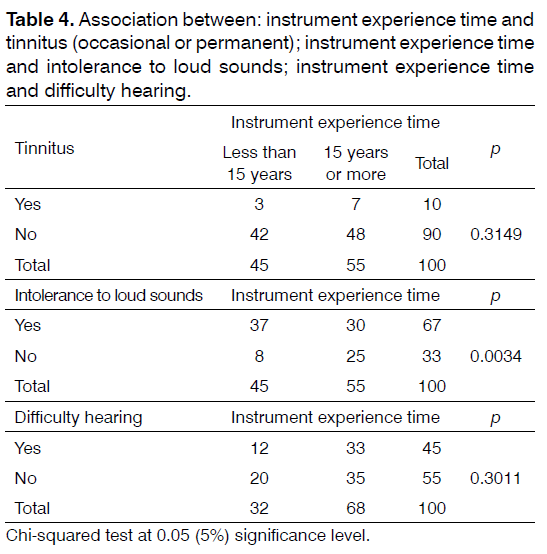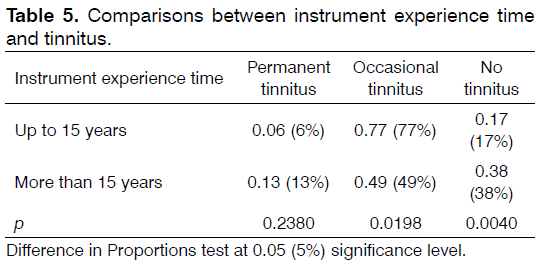The International Tinnitus Journal
Official Journal of the Neurootological and Equilibriometric Society
Official Journal of the Brazil Federal District Otorhinolaryngologist Society
ISSN: 0946-5448

Google scholar citation report
Citations : 12717
The International Tinnitus Journal received 12717 citations as per google scholar report
The International Tinnitus Journal peer review process verified at publons
Indexed In
- Excerpta Medica
- Scimago
- SCOPUS
- Publons
- EMBASE
- Google Scholar
- Euro Pub
- CAS Source Index (CASSI)
- Index Medicus
- Medline
- PubMed
- UGC
- EBSCO
Volume 20, Issue 1 / June 2016
Research Article Pages:48-53
10.5935/0946-5448.20160009
Occurrence of tinnitus and other auditory symptoms among musicians playing different instruments
Authors: Debora Luders; Claudia Giglio de Oliveira Goncalves; Adriana Bender Moreira de Lacerda; Luciana Santos Gerosino da Silva; Jair Mendes Marques; Valana Nicole Sperotto
PDF
Abstract
Introduction: Tinnitus is one of the most reported auditory symptoms among musicians and can negatively influence their ability to work, sometimes even more severely than hearing loss.
Objectives: To analyze the occurrence of tinnitus and other auditory symptoms in musicians who play different instruments.
Methods: One hundred musicians participated by answering a questionnaire on instrument played, practice time with the instrument, occurrence of tinnitus, hearing difficulties, and intolerance to loud sounds. The symptoms were analyzed in relation to gender, musical instrument, and time of experience using statistical tests such as the Chi-squared test and Difference in Proportions test at a significance level of 0.05 as well as finding the Prevalence Ratio.
Results: Tinnitus was the most frequent symptom among musicians, especially among those who play amplified instruments. There was an association between tinnitus and hearing difficulty, and between instrument experience time and intolerance to loud sounds. The proportion of musicians with occasional tinnitus was high among those with less than 15 years of musical practice, and 4.53 times more prevalent in those with more than 15 years of experience.
Conclusion: The presence of auditory symptoms, especially tinnitus, among musicians reinforces the need for implementation of hearing conservation programs for this profession
Keywords: music, tinnitus, health promotion, hearing.
Introduction
In recent decades, many studies have shown hearing loss in classical musicians [1-8] as well those from other music styles [9-18] , due to constant exposure to high sound pressure levels. Most of these professionals have shown a higher incidence of hearing symptoms such as tinnitus and hyperacusis than found in the general population.
Among musicians, such symptoms may negatively affect their ability to work, sometimes even more severely than hearing loss because such symptoms may result in perception musical difficulties [3,5-7,18-21] .
Hearing loss, as well as other auditory symptoms, comes from exposure to loud music in various situations, such as group rehearsals, individual practice, and concerts. Studies have revealed that the sound intensity during these activities go beyond the limits of tolerance, endangering the hearing health in these profissionals [10,16,22] .
Tinnitus is often considered an early indication of possible hearing damage [23,24] . Musicians present tinnitus twice as often as the general adult population in Germany [25] .
So while it is true that musicians, as well as workers exposed to intense noise, are at risk for hearing loss, it appears that the routines and working conditions in musicians make them very different from other workers, as daily they face specific noise exposure at work. In addition, musicians are exposed to different combinations of exposure time, intensity, and frequency spectrums [26] .
Based on these facts, this study aimed to analyze the occurrence of tinnitus and other auditory symptoms in musicians who play different instruments.
Materials and Methods
This study was approved by the Research Ethics Committee, protocol No. 1.164.278 and all participants signed the consent form.
Participated in this study 100 musicians, who play different musical instrument in the city of southern Brazil. The subjects underwent an audiological assessment in a university clinic.
Adopted as inclusion criteria were: being a musician of any type of instrument and playing a musical instrument for at least one year. Exclusion criteria was related to exposure to occupational noise.
All participants answered a questionnaire containing information on instrument played, instrument experience time, occurrence of tinnitus, hearing difficulties, and intolerance to loud sounds.
The results were first presented descriptively and then the association was analyzed between the occurrence of each hearing symptom and: the type of instrument played; and instrument experience time. The Chi-squared test was applied with 0.05 significance. For this analysis the results were categorized as “not occurring” (when the symptom never occurs) or “yes” (when the symptom is permanent or occurs occasionally).
Through the Difference in Proportions test, the occurrence of tinnitus was analyzed among males and females and between musicians with up to 15 years of experience and over 15 years of musical experience.
Next, the responses to the symptoms were categorized as “not occurring (when the symptom never occurs), “sometimes” (when the symptom occurs occasionally), or “yes” (when the symptom is permanent). Then the Prevalence Ratio was calculated, at a significance level of 0.05, between the presence of constant and occasional tinnitus compared to the absence of tinnitus, taking into account gender and instrument experience time for the participants.
Results
The musicians in the study had ages from 18 to 64 (mean age 33.2 years, median 33 years and standard deviation of 12.8 years), 30% were female and 70% male. Among the 100 participating musicians, 51% play string instruments, 24% wind instruments, 18% amplified instruments, and 7% percussion instruments.
Table 1 shows, descriptively, the occurrence of tinnitus symptoms (occasional or permanent), difficulty hearing, and intolerance to loud sounds by instrument type.
Regarding auditory symptoms, tinnitus (occasional or permanent) was the most frequent among musicians (72%), especially among those who play amplified instruments (77.78%), followed by intolerance to loud sounds (67%), which was also more frequent among musicians playing amplified instruments (94.45%).
Next, tinnitus was described according to occurrence (occasional or permanent) in relation to gender and musical instrument, as shown in Table 2.
Analyzing Table 2 for the females, you can see that 100% of women who play wind instruments, 63.64% of
women who play string instruments, and 50% of women who play amplified instruments complain of occasional tinnitus. In males, the highest incidence of occasional tinnitus is 75% for the musicians playing amplified instruments, 55.17% of the musicians who play stringed instruments, and 52.63% of the musicians who play wind instruments. Permanent tinnitus was reported by five (17.24%) musicians who play string instruments, two (10.53%) who play wind instruments, and one (6.25%) musician who plays amplified instrument. Compared to females, there were reports of permanent tinnitus in only one (4.54%) musician that plays stringed instrument.
Through the Difference in Proportions test, it was found that there was no significant difference between the proportion of tinnitus events between male and female.
Table 3 shows the association between tinnitus and other symptoms surveyed.
The only significant association was between tinnitus and hearing difficulties (p = 0.0454).
The association between instrument experience time and the symptoms studied is presented in Table 4.
Analyzing Table 4, it is clear that there was an association only between instrument experience time and intolerance to loud sounds.
There was no association between instrument experience time and other symptoms: tinnitus (occasional or permanent); difficulty hearing; and intolerance to loud sounds and the type of musical instrument.
Table 5 shows the comparisons between instrument experience time and tinnitus.
In Table 5, the data show a significant difference between the proportions in symptoms for musicians with up to 15 years of experience and over 15 years of experience for occasional tinnitus and for no tinnitus.
There was no significant difference between the frequency of tinnitus between male and female subjects.
The analysis of the prevalence ratio revealed that occasional tinnitus is 4.53 times more prevalent among musicians with up to 15 years of practice than for those with over 15 years of practice.
Discussion
Regarding the auditory symptoms presented by the musicians, the present study found tinnitus to be the most common (72%), especially among musicians playing amplified instruments, followed by intolerance to loud sounds (67%), as seen in Table 1. Among the 72 musicians who reported tinnitus, nine reported the symptom to be permanent and 63 occasional, with a greater occurrence among men who play amplified instruments (75%) and among women who play wind instruments (63.64), as shown in Table 2. There was an association between tinnitus and hearing difficulties (p = 0.0454), as seen in Table 3 and an association between instrument experience time and intolerance to loud sounds (Table 4). It was also found that occasional tinnitus occurs more in musicians with up to 15 years of practice (Table 5), and is 4.53 times more prevalent in this group.
Several studies have demonstrated the presence of these symptoms in different musical groups.
One study [22] compared two groups of college students - a group of jazz band students during rehearsal and another group of non-music students in a regular classroom - and found that 64% of the music students reported tinnitus while none of the control group students reported the symptom.
In another study [27] , 90 college musicians also reported tinnitus symptoms (in more than a third of the population investigated) and 12% reported a history of hearing loss.
Another study [6] found that among 145 musicians, 34 (24%) reported tinnitus, 24 men and 10 women, and among those with tinnitus 42% reported it to be permanent and 24% said that it affects their sleep.
In a study [25] with orchestra musicians, the authors found 15.8% of musicians affected by tinnitus, and 2.1% complained of strong hearing loss.
Another study with orchestra musicians [28] showed 43% of respondents reporting hearing loss, 9% with permanent tinnitus and 42% with temporary tinnitus. There was a clear relationship between reported tinnitus and hearing loss, with 79% of those who reported permanent tinnitus also reporting a loss of hearing. The same was observed in this study, where occasional or temporary tinnitus was reported by most male subjects that play amplified instruments, as can be seen in Table 2.
When evaluating complaints by orchestra musicians, one study [2] , found 52.1% of musicians had intolerance to loud sounds, 43.4% had tinnitus, and 21.7% had hearing loss.
Another study [29] with 16 orchestra musicians, 12 males and five females, said tinnitus was one of the main complaints reported by 43% of the sample, followed by intolerance to intense sound at 19%. Furthermore, normal hearing was found in four of the seven musicians with tinnitus and all the musicians mentioned intolerance to loud sounds. In the present study, there was an association between the type of instrument played and intolerance to loud sounds, but between occasional tinnitus and instrument experience time up to 15 years, there was a significant difference.
By comparing the hearing in violinists and nonmusicians (eight females and two males), one study30 revealed that there was a higher incidence of bilateral tinnitus among violinists, although the difference was not significant, and a tendency to higher incidence of unilateral tinnitus in the left ear. In the population studied, it was observed that 63.63% of women who play stringed instruments reported occasional tinnitus, agreeing with that research.
Also in relation to orchestra musicians, a study [7] conducted in 2009 with 241 musicians (113 females and 128 males) presented as part of the results that most of them had tinnitus, especially in the left ear, as well as hyperacusis. In the audiological evaluation, 42 musicians (17%) reported tinnitus at the time. When evaluated, the results showed that the tinnitus sensation level ranged from 0 to 32dB (average of 4 dB). Ten musicians (25%) indicated that the tinnitus sound was less than 4000 Hz; 15 participants (35%) indicated the tone to be between 4000 and 8000 Hz, and 17 (40%) indicated that it was above 8000 Hz. There was no significant difference between genders.
Tinnitus has also been reported in studies with musicians from other styles. In a study [31] performed with an instrumental and vocal band, auditory symptoms most commonly reported by 34 members (among musicians, singers and sound board operator) were intolerance to loud sounds (58.8%), tinnitus (47%), and hearing loss (25.7%). In an earlier study [32] , authors found the symptom of intolerance to loud sounds in 42% of musicians, tinnitus in 39%, and hearing loss in 13%.
Another study [10] , with 23 musicians from different pop-rock bands, the most frequent hearing complaints were tinnitus (with 39.1% since entering the profession, 56.5% with tinnitus after a presentation) and intolerance to loud sounds (with 34.8% since entering the profession, 30.4% after a presentation).
In Norway [33] , 111 rock musicians had hearing thresholds evaluated and the prevalence and characteristics of tinnitus (when reported). 20% of the population sample presented the presence of chronic tinnitus, but no significant association between tinnitus and permanent hearing loss - data that differ from those found in this study where there was an association between tinnitus and hearing difficulties (p = 0.0454) as shown in Table 3.
It was also observed in a study [34] in Santa Catarina with 21 musicians from various musical styles, and a mean age of 29 years, that hearing loss was found in 42.9% of the sample, and mostly in males. The auditory symptoms were tinnitus (52.4%), ear fullness (38.1%), difficulty in understanding speech (28.6%), and dizziness (23.8%).
One study [35] , with 30 musicians between 18 and 37 years of age, reported that the most common symptoms were tinnitus and difficulty understanding speech in noisy environments.
Military band musicians have also been evaluated. One study [13] with 50 subjects revealed that 76% of the musicians had tinnitus and 54% reported difficulty hearing.
A study [36] performed with musicians of frevo and maracatu music styles found tinnitus in both groups, occurring in 52.63% of frevo musicians and 67.74% of maracatu musicians.
In another study [37] with 41 professional rock, pop, and jazz musicians in Israel, between 20-64 years old, in which 81.8% were male, tests were performed for the detection of hearing thresholds and a questionnaire about subjective symptoms was given. It was observed that there was a correlation between tinnitus, hearing loss, and exposure to high sound pressure levels.
Several studies, both national and international, have brought to light the fact that tinnitus is one of the main effects of excessive loud music exposure [19,37] .
One should take into account that the presence of occasional or temporary tinnitus, as reported in several studies, should be viewed as a warning sign, as a reaction of the auditory system to exposure to high sound pressure levels, which can cause permanent hearing alterations. This fact clearly demonstrates the risk that musicians are constantly subjected to in their profession.
Conclusion
Auditory symptoms such as tinnitus, intolerance to loud sounds and hearing difficulties are present in musicians who play different types of instruments, and tinnitus is the most frequent symptom. It was observed that there was an association between tinnitus and hearing difficulty, as well as between instrument experience time and intolerance to loud sounds. Occasional tinnitus is 4.53 times more prevalent among musicians with up to 15 years of musical practice compared to musicians with over 15 years of practice.
The results reinforce the need to implement hearing conservation programs for musicians.
References
- Kähäri KR, Axelsson A, Hellström PA, Zachau G. Hearing development in classical orchestral musicians. A follow-up study. ScandAudiol. 2001;30(3):141-9.
- Marchiori LLM, Melo JJ. Comparação das queixasauditivas com relação à exposiçãoaoruídoemcomponentes de orquestrasinfônica. Pró-Fono. 2001;13(1):9-12.
- Laitinen H. Factors affecting the use of hearing protectors among classical music players. Noise Health. 2005;7(26):21-9.
- Morais D, Benito JI, Almaraz A. Acoustic trauma in classical music players. ActaOtorrinolaringol Esp. 2007;58(9):401-7.
- Emmerich E, Rudel L, Richter F. Is the audiologic status of professional musicians a reflection of the noise exposure in classical orchestral music? Eur Arch Otorhinolaryngol. 2008;265(7):753-8.
- Laitinen H, Poulsen T. Questionnaire investigation of musicians' use of hearing protectors, self reported hearing disorders, and their experience of their working environment. Int J Audiol. 2008;47(4):160-8.
- Jansen EJ, Helleman HW, Dreschler WA, de Laat JA. Noise induced hearing loss and other hearing complaints among musicians of symphony orchestras. Int Arch Occup Environ Health. 2009;82(2):153-64.
- Schmidt JH, Pedersen ER, Paarup HM, Christensen-Dalsgaard J, Andersen T, Poulsen T, et al. Hearing loss in relation to sound exposure of professional symphony orchestra musicians. Ear Hear. 2014;35(4):448-60.
- Juman S, Karmody CS, Simeon D. Hearing loss in steelband musicians. Otolaryngol Head Neck Surg. 2004 Oct;131(4):461-5.
- Santoni CB, Fiorini AC. Pop-rock musicians: assessment of their satisfaction provided by hearing protectors. Braz J Otorhinolaryngol. 2010;76(4):454-61.
- Hoffman JS, Cunningham DR, Lorenz DJ. Auditory thresholds and factors contributing to hearing loss in a large sample of percussionists. Med ProbPerf Art. 2006;21(2):47-58.
- Schmuziger N, Patscheke J, Probst R. Hearing in nonprofessional pop/rock musicians. Ear Hear. 2006;27(4):321-30.
- Gonçalves CGO, Lacerda ABM, Zocoli AMF, Oliva FC, Almeida SB, Iantas MR. Percepção e o impacto da músicanaaudição de integrantes de bandamilitar. Rev Soc Bras Fonoaudiol. 2009;14(4):515-20.
- Maia JRF, Russo ICP. Estudo da audição de músicos de rock and roll. Pró-Fono. 2008;20(1):49-54.
- Monteiro VM, Samelli AG. Estudo da audição de ritmistas de umaescola de samba de São Paulo. Rev Soc Bras Fonoaudiol. 2010;15(1):14-8.
- Gonçalves CGO, Lacerda ABM, Zeigelboim BS, Marques JM, Luders D. Limiaresauditivosemmúsicosmilitares: convencionais e altasfrequências. CoDAS. 2013;25(2):181-7.
- Schink T, Kreutz G, Busch V, Pigeot I, Ahrens W. Incidence and relative risk of hearing disorders in professional musicians. Occup Environ Med. 2014;71(7):472-6.
- Arezes PM, Bernardo CA, Mateus OA. Measurement strategies for occupational noise exposure assessment. A comparison study in different industrial environments. Int J IndErgon 2005;42(1):172-7.
- Reid AW, Holland MW. A Sound Ear II The Control of Noise at Work Regulations 2005 and Their Impact on Orchestras. London: The Association of British Orchestras; 2008.
- Pawlaczyk-Łuszczyńskam, Dudarewicz A, Zamojska M, Śliwińska-Kowalskam. Hearing ability in orchestral musicians. Arch Acoust. 2010;35(4):579-94.
- Toppila E, Koskinen H, Pyykkö I. Hearing loss among classical-orchestra musicians. Noise Health. 2011;13(50):45-50.
- Gopal KV, Chesky K, Beschoner EA, Nelson PD, Stewart BJ. Auditory risk assessment of college music students in jazz band-based instructional activity. Noise Health. 2013;15(65):246-52.
- Rice CG, Rossi G, Olina M. Damage risk from personal cassette players. Br J Audiol. 1987;21(4):279-88.
- World Health Organization. Prevention of Noise Induced Hearing Loss, WHO-PDH Informal Consultation. Geneva: World Health Organization; 1997. 44p.
- Zander MF, Spahn C, Richter B. Employment and acceptance of hearing protectors in classical symphony and opera orchestras. Noise Health. 2008;10(38):14-26.
- Lüders D, Gonçalves CGO. Trabalho e saúdenaprofissão de músico: reflexõessobre um artistatrabalhador. Tuiuti: Ciênc Cult. 2013;47:123-37.
- Olson AD, Gooding LF, Shikoh F, Graf J. Hearing Health in College Instrumental Musicians and Prevention of Hearing Loss. Med Probl Perform Art. 2016;31(1):29-36.
- O'Brien I, Ackermann BJ, Driscoll T. Hearing and hearing conservation practices among Australia's professional orchestral musicians. Noise Health. 2014;16(70):189-95.
- Namuur FABM, Fukuda Y, Onishi ET, Toledo RN. Avaliaçãoauditivaemmúsicos da orquestrasinfônica municipal de São Paulo. Rev Bras Otorrinolaringol. 1999;65(5):390-5.
- Azevedo MF, Oliveira C. Audição de violinistasprofissionais: estudo da funçãococlear e da simetriaauditiva. Rev Soc Bras Fonoaudiol. 2012;17(1):73-7.
- Mendes MH, Morata TC, Marques JM. Aceitação de protetoresauditivospeloscomponentes de banda instrumental e vocal. Rev Bras Otorrinolaringol. 2007;73(6):785-92.
- Mendes MH, Koemler LA, Assencio-Ferreira VJ. A prevalência de perdaauditivainduzidapeloruídoemmúsicos de banda instrumental. Rev CEFAC. 2002;4(3):179-85.
- Størmer CC, Laukli E, Høydal EH, Stenklev NC. Hearing loss and tinnitus in rock musicians: A Norwegian survey. Noise Health. 2015;17(79):411-21.
- Martins JPF, Magalhães MC, Sakae TM, Magajewski RL. Avaliação da perdaauditivainduzidaporruídoemmúsicos de Tubarão-SC. ArqCatarin Med. 2008;37(4):69-74.
- Amorim RB, Lopes AC, Santos KTP, Melo ADP, Lauris JRP. Auditory Alterations for Occupational Exposition in Musicians. Int Arch Otorhinolaryngol. 2008;12(3):377-83.
- Andrade AIA, Russo ICP, Lima MLLT, Oliveira LCS. Avaliaçãoauditivaemmúsicos de frevo e maracatu. Rev Bras Otorrinolaringol. 2002;68(5):714-20.
- Halevi-Katz DN, Yaakobi E, Putter-Katz H. Exposure to music and noise-induced hearing loss (NIHL) among professional pop/rock/jazz musicians. Noise Health. 2015;17(76):158-64.
References
Departament of Audiology and Communication Disorders, Tuiuti University of Paraná. Curitiba, PR, Brazil. E-mail: debora.luders@utp.br / claudia.goncalves@utp.br / adriana.lacerda@utp.br / luquitafono@gmail.com / jair.marques@utp.br / vasperotto@hotmail.com
Institution: Tuiuti University of Paraná.
Send correspondence to:
Débora Lüders
Rua Atílio Bório, 119 apto 302
Cristo Rei, Curitiba, PR, Brazil. CEP: 80050-250
E-mail: debora.luders@utp.br
Paper submitted to the RBCMS-SGP (Publishing Management System) on March 28, 2016; and accepted on April 6, 2016. cod. 234
Citation: Luders D, Goncalves CGO, Lacerda ABM, Silva LSG, Marques JM, Sperotto VN. Occurrence of tinnitus and other auditory symptoms among musicians playing different instruments. Int Tinnitus J. 2016; 20(1) : 48-53



